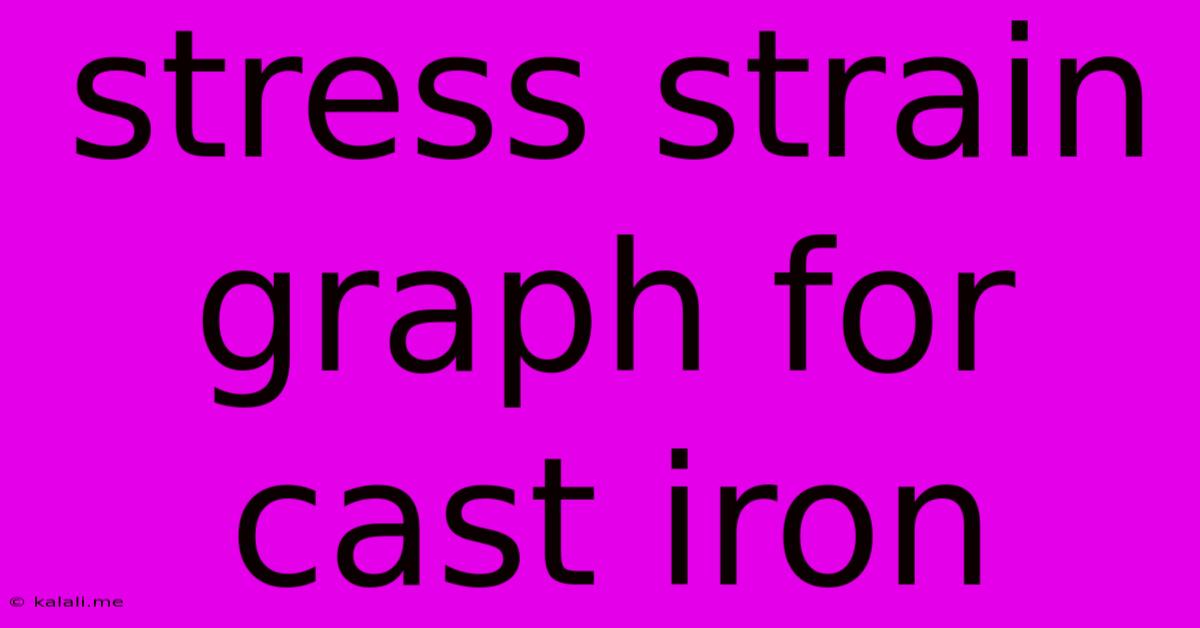Stress Strain Graph For Cast Iron
Kalali
Jun 14, 2025 · 3 min read

Table of Contents
Understanding the Stress-Strain Graph for Cast Iron: A Comprehensive Guide
Meta Description: This article provides a comprehensive explanation of the stress-strain graph for cast iron, detailing its unique characteristics, brittle behavior, and implications for engineering applications. Learn about the ultimate tensile strength, yield strength (or lack thereof), and the importance of understanding its fragility.
Cast iron, a widely used ferrous alloy, exhibits unique mechanical properties reflected in its distinctive stress-strain curve. Unlike ductile materials like steel, which display a clear yield point and significant plastic deformation before failure, cast iron's behavior is primarily brittle. Understanding the stress-strain graph for cast iron is crucial for engineers to predict its behavior under load and ensure safe design practices.
Key Characteristics of the Cast Iron Stress-Strain Graph
The stress-strain graph for cast iron typically shows a steep, almost linear, elastic region followed by immediate failure. This is in stark contrast to ductile materials which exhibit a yielding region and significant plastic deformation before fracture. Key features include:
-
Absence of a Defined Yield Point: Unlike ductile materials, cast iron lacks a clearly defined yield point. This means there's no distinct point where plastic deformation begins. The material transitions directly from elastic behavior to fracture.
-
High Compressive Strength: Cast iron possesses significantly higher compressive strength compared to its tensile strength. This characteristic makes it suitable for applications where compressive loads are dominant.
-
Low Ductility and Elongation: Its brittle nature results in very low ductility and minimal elongation before failure. This means it has limited capacity to deform plastically before breaking.
-
High Ultimate Tensile Strength: While not exhibiting much ductility, cast iron does possess a relatively high ultimate tensile strength, meaning it can withstand a considerable amount of tensile stress before failure. However, this strength is significantly lower than its compressive strength.
-
Brittle Fracture: Failure typically occurs suddenly and without significant warning, characterized by a brittle fracture with minimal plastic deformation. This necessitates careful consideration of design factors to prevent catastrophic failure.
Interpreting the Graph: Tensile and Compressive Behavior
The stress-strain graph highlights the significant difference between cast iron's tensile and compressive behavior. Under tensile loading, the material fails relatively quickly after the elastic limit is exceeded. In contrast, under compressive loading, it can withstand considerably higher stresses before failure, exhibiting a much steeper curve.
This disparity arises from the microstructure of cast iron, specifically the presence of graphite flakes. These flakes act as stress concentrators under tension, initiating cracks that propagate rapidly leading to fracture. Under compression, the graphite flakes are less detrimental, leading to superior compressive strength.
Engineering Implications and Applications
The brittle nature of cast iron demands careful consideration in engineering design. Factors such as stress concentration, impact loading, and fatigue must be meticulously analyzed to prevent premature failure. Despite its limitations, cast iron’s high compressive strength, good casting properties, and relatively low cost make it suitable for applications such as:
- Engine Blocks and Cylinder Heads: The high compressive strength is crucial in withstanding combustion pressures.
- Machine Bases and Frames: Its ability to withstand static loads makes it ideal for supporting machinery.
- Pipes and Fittings: In situations where internal pressure is managed effectively.
- Manhole Covers: Their high compressive strength makes them resistant to crushing.
Conclusion
The stress-strain graph for cast iron reveals its unique and often challenging mechanical properties. Understanding its brittle nature, the absence of a yield point, and its significantly higher compressive strength compared to tensile strength is critical for safe and effective application in engineering designs. Careful consideration of design parameters is crucial to mitigate the risk of brittle fracture and ensure reliable performance. By appreciating these characteristics, engineers can utilize cast iron effectively in appropriate applications, leveraging its advantageous properties while mitigating its inherent limitations.
Latest Posts
Latest Posts
-
Least Common Multiple Of 16 And 32
Jun 15, 2025
-
Distance To Center Of Equilateral Triangle
Jun 15, 2025
-
How Many Meters Are In One Light Year
Jun 15, 2025
-
1st Nobel Prize Winner In India
Jun 15, 2025
-
What Is The Si Unit For Displacement
Jun 15, 2025
Related Post
Thank you for visiting our website which covers about Stress Strain Graph For Cast Iron . We hope the information provided has been useful to you. Feel free to contact us if you have any questions or need further assistance. See you next time and don't miss to bookmark.